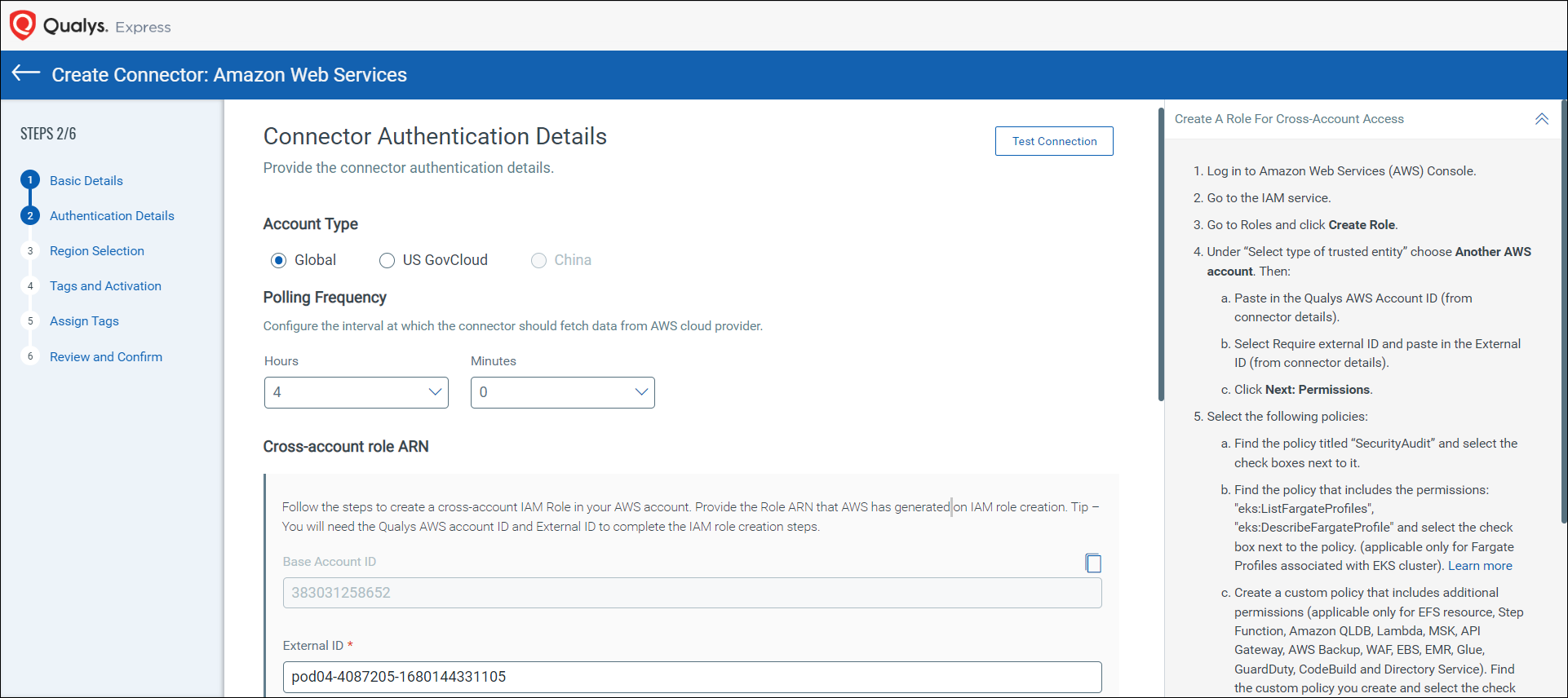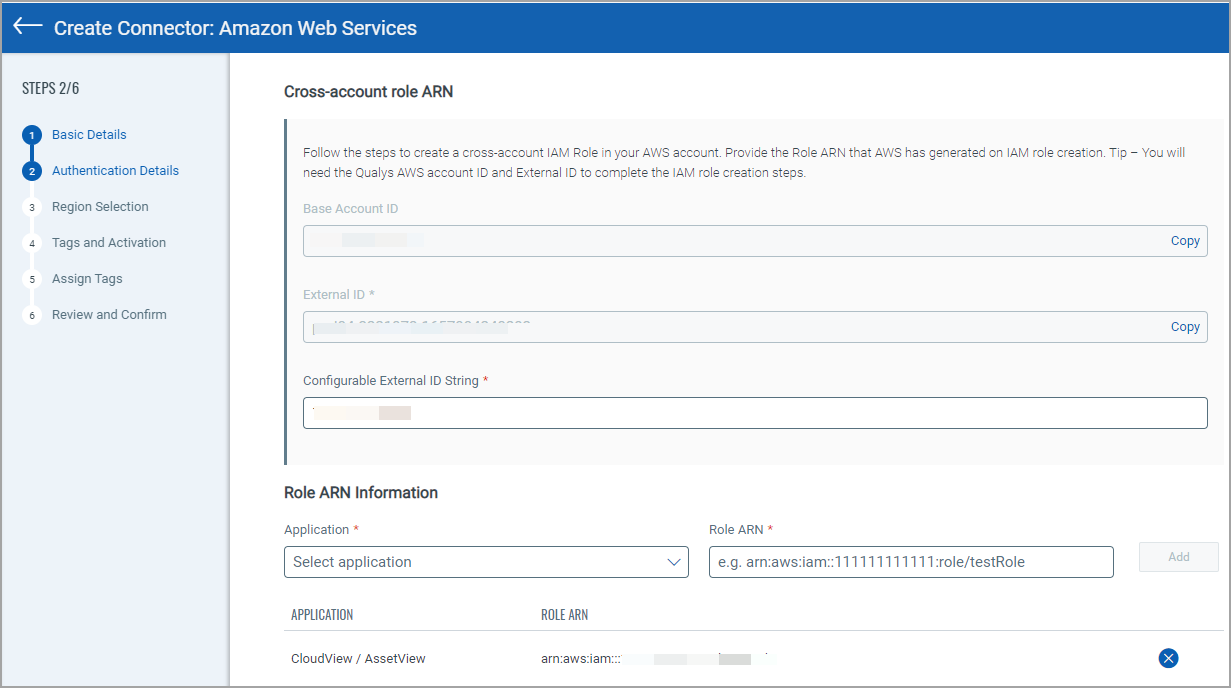Create AWS Connector
Go to the Connectors tab, click Amazon Web Services Connectors, and then click Create Connector, and our wizard can walk you through the steps.
Step 1: Basic DetailsBasic Details
 Provide a name and description for the connector. We recommend you provide a unique name for the connector.
Provide a name and description for the connector. We recommend you provide a unique name for the connector.
Select applications that are applicable for the connector.
Select Enable Remediation to enable remediation on the connector. You need to configure additional permissions before you enable remediation for AWS connectors.
Note: Ensure that the connector has write access to the AWS account for which you enable remediation.
Step 2: Authentication Details
- Account TypeAccount Type
 Select an account type for your connector: Global, US GovCloud or China. You can choose only one account type per connector.
Select an account type for your connector: Global, US GovCloud or China. You can choose only one account type per connector.
- Polling FrequencyPolling Frequency
Select a frequency at which the connector should poll the cloud provider and fetch data.
By default, the connector polling frequency is configured for every 4 hours. As a result, the connector connects with the cloud provider every 4 hours to fetch the data.
You can configure frequency from minimum one hour to maximum 24 hours. We recommend that you configure a frequency of 4 hours or more for optimal use of your connector. Configuring a low polling frequency (lesser than 4 hours) can affect the performance of the connector and may result in AWS API throttling error.
- Cross-account ARNCross-account ARN
This lets you grant Qualys access to your AWS resources without sharing your AWS security credentials. Qualys accesses your AWS resources by assuming the IAM role that you create in your AWS account. Learn more.
AWS requires that vendors provide a unique external ID value amongst all their customers when providing a vendor account for a trust relationship. However, we no longer require customers to adhere to any fixed format for external ID. Learn more
In the Application list, select CloudView/AssetView, paste Role ARN, and click Add.

- Test ConnectionTest Connection
Click Test Connection to verify if the connector can successfully authenticate using the provided role ARN information. If the test connection is successful, proceed with the connector creation process. If the test connection fails, you may need to check and update the authentication details.
Step 3: Region SelectionRegion Selection
Select regions to discover the asset/resource and fetch the data from all the selected regions.

Step 4: Tags and ActivationTags and Activation
We can activate AWS assets for scanning automatically so you do not have to take this extra step. Select the required check box to enable activation for the required app. We automatically activate the assets as they are discovered and even assign them tags if you want.
Enabling Cloud Perimeter Scan
When you select the Automatically activate all assets for VM Scanning application check box, you can see a check box to enable cloud perimeter scan.

Select the Enable Cloud Perimeter Scan if you want to enable launching perimeter scans on your EC2 assets.
Perimeter scan jobs are run automatically based on the settings defined in the Scan Settings step or in the Cloud Perimeter Scan - Global Scan Configuration.
Enabling Zero-touch API Based Scan
When you select the Automatically activate all assets for VM Scanning application check box, a check box to enable zero-touch API based scan becomes visible.

Select the Enable Zero-touch API based Scan if you want to utilize cloud native API to perform real-time vulnerability assessments on new EC2 instances.
The API scan captures events from your AWS environment in real-time to identify new instances in the cloud inventory. To allow Qualys to listen to events in your AWS account for API scanning, refer to Configure Zero-touch API Based Scan.
Select Asset Tags
We recommend you create at least one generic asset tag (for example, EC2) and have the connector automatically apply that tag to all imported assets. You can add more tags to your EC2 assets based upon discovered EC2 metadata.
Step 5: Scan SettingsScan Settings
The step for defining scan settings is available only if you select the Enable Cloud Perimeter Scan check box in the Tags and Activation step.
In this step, you can define customized settings for cloud perimeter scans for the specific connector that you are creating.
If you do not define the custom scan configuration for the connector, the global scan configuration is used for launching the cloud perimeter scan. For details on global scan configuration, see Cloud Perimeter Scan - Global Scan Configuration.
Select the Enable custom scan configuration check box. You can define scan settings, such as scan prefix, option profile, recurrence, and timezone. Show meShow me
For details of the scan settings fields, see Cloud Perimeter Scan - Global Scan Configuration.
Step 6: Assign TagsAssign Tags
Assign tags to the connector that you are creating. You can also create a new tag. For details on creating new tags, see Configure Tags in Qualys CyberSecurity Asset Management documentation.
Step 7: ConfirmationConfirmation
Review the connector settings you configured and then click Create Connector.
That’s it! The connector establishes a connection with Amazon Web Services to start discovering resources from configured region.
Once the connector is created, you can run the connector, disable or delete the connector, and view assets and resources information.
The Amazon Web Services page displays the list of AWS connectors. The Status column indicates the status of the connector created, that is, Completed successfully, Completed with errors, Queued, Synchronizing, and Disabled.
Frequently Asked Questions
What if my EC2 instances have IP address changes?What if my EC2 instances have IP address changes?
Your EC2 instances may have IP address changes. We can continue to scan your EC2 instances because we scan by EC2 instance ID (not by IP address). If changes are found by an EC2 scan, you can see the new IP addresses in your scan results. Once these scan results are processed the new IP addresses are shown in your account and is included in your scan reports.
AWS assets: Status and BehaviorAWS assets: Status and Behavior
The AWS assets are detected by EC2 connector and/or Cloud Agent. The status in asset records from the EC2 connector is updated with every connector run. However, if an asset in terminated, only the asset records from EC2 connector reflects the terminated status after connector run.
The asset records from Cloud Agent running in AWS and instances from EC2 connector are automatically merged into a single asset record and it correctly reflects the status. The asset records from Cloud Agent, which are not merged with record fetched via connector does not reflect the terminated status.
 Provide a name and description for the connector. We recommend you provide a unique name for the connector.
Provide a name and description for the connector. We recommend you provide a unique name for the connector. Select an account type for your connector:
Select an account type for your connector: 


